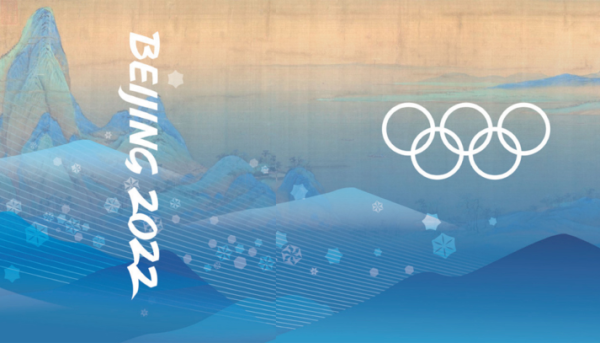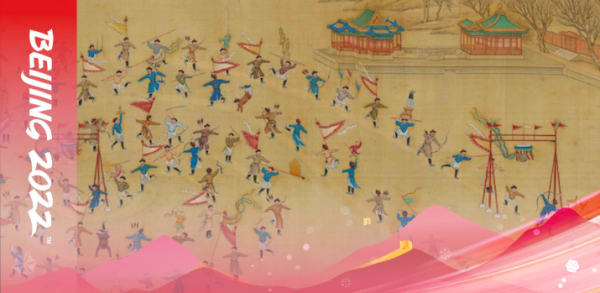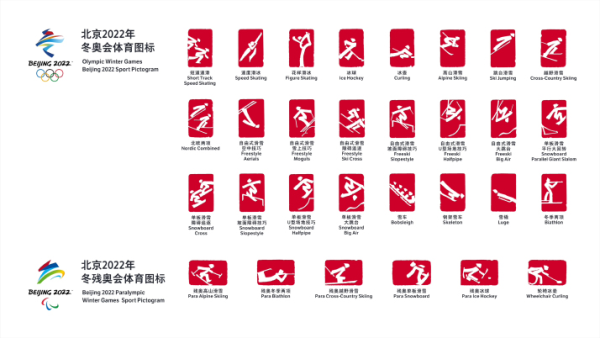Almost seven years after winning its bid to host the Olympic Winter Games in Beijing, China will finally present its long-prepared competition venues to the world next month. In addition to the architectural design of the venues, the visual identity of the Games is also expected to be a highlight. The emblems, pictograms, mascots and core graphics all contribute to the appearance of each venue and of the Games as a whole.
The design team led by Lin Cunzhen, Deputy Dean of the Design School with the China Central Academy of Fine Arts (CAFA), has been working on creations that have been used as reference works for all graphic designs appearing at the Games. These include those on stadiums, uniforms, tickets and merchandise. During the design phase of these works, traditional Chinese culture has been a major source of inspiration.


Design works integrating the painting of Bingxi and A Thousand Miles of Rivers and Mountains with core graphics (COURTESY PHOTO)
Traditional art
The emblem, pictograms and backdrops for the Beijing Games aim to underline the passion and vitality of winter sports. Chinese characters, the ancient scripts used on Chinese ink seals and traditional paintings have all served as inspirations.
The emblem for the Games uses the figure of an ice skater on top and a skier underneath to form the Chinese character dong (winter). “The flowing, ribbon-like motif between the two figures symbolizes rolling mountains, Olympic venues, ski runs and skating rinks,” Lin, who is in charge of the overall visual identity of the Olympics under the Culture and Ceremonies Department of the Beijing Organizing Committee for the 2022 Olympic and Paralympic Games (BOCOG), said in an interview with China Central Television.
The Beijing 2008 Olympics emblem “Chinese Seal, Dancing Beijing” was inspired by Chinese calligraphy. Similarly, the 24 pictograms of the Winter Olympic Games are inspired by traditional Chinese pictographs and the art of seal cutting, Dai Yisha, a project manager in the BOCOG Culture and Ceremonies Department, told Beijing Review. Dai is also an assistant professor at the Beijing Institute of Fashion Technology.
According to Dai, the department was tasked with creating the pictograms in May 2020, at which time they visited the Chinese Academy of History for consultation. During the visit, they were inspired by ancient Chinese pictograms and calligraphy. Based on photos of athletes provided by the sports authorities, they captured the most characteristic moments of each sport’s athletes in action. After comparison and selection, they chose running script, known as xingshu, as the script in which to depict each pictogram. The pictograms of sports such as figure skating and cross-country skiing were revised several times by changing the direction and size of the sketches to fully convey the speed and power of the sports and make international audiences identify each sport easily.
After the designs were created digitally, the team then turned to Zhang Mingguan, a professor at the CAFA. Zhang carved each of the pictograms onto stone seals to test the designs, and the team then revised the digital image based on Zhang’s results. Finally released in 2021, the pictograms will be widely applied in areas such as event signposting, advertising, communications, TV broadcasting and souvenir design.
Traditional Chinese painting is yet another source of inspiration for the Olympic designers. According to Dai, a painting titled Bingxi, which means ice games, produced during the Qing Dynasty (1644-1911), depicts ice skaters performing for the imperial audience in the 18th century. The scene depicted in the painting demonstrates that winter sports have a long history in China. The painting is now in the collection of the Palace Museum in Beijing. In the design of banners, the team merged the Bingxi with mountain shapes taken from traditional Chinese paintings. Some of the mountainous silhouettes are also based on pictures of the Taihang Mountains, which envelop some of the competition zones.
Other paintings, such as A Thousand Miles of Rivers and Mountains created in the Song Dynasty (960-1279) and ink paintings of plum blossoms, which represent nobility, strength and modesty in Chinese culture, have also been incorporated into the Olympic designs. The designs have been presented in halls for athletes, guests and reporters at the BOCOG.

Pictograms of the Beijing 2022 Games (COURTESY PHOTO)
Palettes of the past
Since the Games will coincide with the Chinese New Year this year, red, which is an auspicious color in traditional Chinese culture, has been widely adopted in all the designs. Shuey Rhon Rhon, the mascot of the Paralympics 2022, is a cartoon red lantern, which also carries connotations of auspiciousness and best wishes for the festival. Red lanterns will also be hung across indoor venues during the Games.
Red is only one of the major tones used in the designs. Since the 2004 Olympics in Athens, every Olympic organizing committee has developed a unique system of colors and core graphics. According to Dai, Chinese traditional architecture, paintings and porcelains are major sources of inspiration for the color system developed by China. Dai’s team also collected tones of the urban and natural winter landscapes from all three competition zones—downtown Beijing, Zhangjiakou and Yanqing—to create the color schemes.
The designers developed a system that uses 13 colors. The five major ones are glowing red, spring yellow, sapphire sky, Great Wall gray and snow white. The team revised the colors multiple times in order to use them to their best effect during broadcasts. According to Dai, the color gray, previously used in the Beijing 2008 Olympics, is derived not only from the color of the Great Wall, but also from Beijing’s traditional courtyard housing, known as a siheyuan.
Many of the colors stem from minerals used by traditional Chinese painters. Mineral pigments were widely applied in ancient Chinese artworks. These primitive mineral pigments are chemically stable and do not fade easily over time. Through the use of such pigments, ancient artworks such as cave paintings and glazed ceramics have retained their stunning colors, even after thousands of years.
Dai also explained that the color known as sapphire sky is based on the color of the blue glaze used on traditional Chinese blue and white ceramics. The main material used to produce blue glaze was brought into China along the ancient Silk Road hundreds of years ago. Sapphire sky is the major color used in the construction of Big Air Shougang, also known as the “Crystal Shoe,” a steep ski ramp located in Beijing’s Shougang Industrial Park, one of the Olympic venues.
Connecting past and present, all elements of the Olympic visual identity are expected to impress the audience during the Games. Even though many of them may only appear in flashes, Dai hopes the designs will garner global attention and that viewers will spot the Chinese elements in each one.
“Our designs feature typical Chinese styles. Through the Olympics, Chinese culture will once again be introduced to the world,” she concluded.
Media Contact
Company Name: Center for the Americas, China International Communications Group
Contact Person: Li Xiaoyang
Email: Send Email
Country: China
Website: https://youtu.be/0GL4XtEZoso














